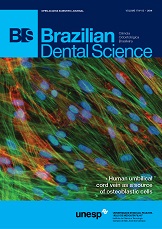Comparison of disinfection protocol of irreversible hydrocolloid (alginate) impressions through plastic and metallic trays
DOI:
https://doi.org/10.14295/bds.2014.v17i3.999Abstract
Introduction: Many studies have evaluated the disinfection of irreversible hydrocolloid impressions through different disinfecting agents. However, impression trays can be source of cross-infection requiring disinfection. This study aimed to determine which would be the most suitable tray (metallic or plastic), available in dental market, and the ideal time to achieve disinfection by using 1% sodium hypochlorite poured into the alginate impression. Material and methods: Thirty dental impressions from the patients aged from 7-12 years and treated in the Discipline of Orthodontics of the institution were divided into two groups according to the impression tray type: 15 impressions through plastic tray (Morelli) and 15 impressions through metallic tray (Tecnodent). The material collection was performed before and after the application of 1% sodium hypochlorite for 3, 5 and 10 minutes. After the incubation period of 48 hours at 37ºC, the microorganism colonies were counted on the plates presenting from 30 to 300 colonies to determine the colony-forming unit (CFU) per mL. CFU/mL results were transformed into logarithm and submitted to statistical analysis by applying ANOVA and Tukey test (p ? 0.05). Results: Greater CFU percentage reduction occurred in alginate after three minutes, in both tray types. Concerning to tray types, it could be observed that the plastic tray showed 100% of reduction after 5 minutes while the metallic tray exhibited 81.49% of reduction after 3 minutes. Conclusion: 1 – The plastic tray showed the most effective disinfection after 5 minutes, with 100% of CFU reduction; 2 – The most effective time of disinfection with 1% sodium hypochlorite poured into the impression was 5 minutes, for both tray types.
Downloads
Downloads
Additional Files
Published
How to Cite
Issue
Section
License
Brazilian Dental Science uses the Creative Commons (CC-BY 4.0) license, thus preserving the integrity of articles in an open access environment. The journal allows the author to retain publishing rights without restrictions.
=================




























